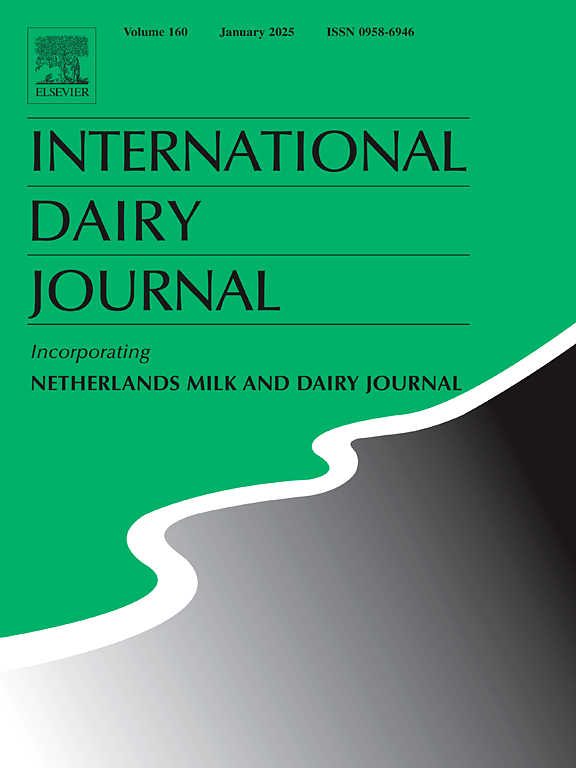Cold storage promotes the emergence and proliferation of Janthinobacterium sp. in raw milk biofilms
IF 3.4
3区 农林科学
Q2 FOOD SCIENCE & TECHNOLOGY
引用次数: 0
Abstract
The low temperatures used during raw milk storage in processing plants, while intended to inhibit microbial growth, fail to prevent psychrotrophic bacteria from colonizing surfaces and forming biofilms. Assessing the diversity of the bacterial community can provide insight into the ability of cold-adapted milk contaminants to develop biofilms during refrigeration. Therefore, biofilms were formed on stainless steel surfaces, at 4 °C using the CDC biofilm reactor at 60 rpm, from three raw milk samples collected at different times. The bacterial diversity and relative abundance of genera in each sample and in its corresponding biofilm were investigated through 16S rRNA gene sequencing. The results revealed that the genera Pseudomonas and Chryseobacterium were predominant in milk (46.36 % and 19.20 %) and biofilm (45.29 % and 24.19 %), whereas Janthinobacterium spp. was predominant exclusively in biofilms, reaching a relative abundance of 25.13 % though barely detectable in raw milk (0.016 %). Furthermore, the most abundant OTU of Janthinobacterium genus matched with J. lividum. On CDC biofilm reactor, J. lividum ATCC 14487 bacterial density reached 5.27 ± 0.45 log cfu/coupon after 5 days of incubation in sterile milk at 4 °C. Cross-streak antagonism tests further demonstrated that J. lividum can coexist in biofilms with Gram-negative strains, particularly Pseudomonas spp. These findings indicate that multi-species biofilms can form during the refrigeration phase of raw milk. They emphasize the risk associated with strains that, although initially present in minimal concentrations, can become predominant within such biofilms, potentially leading to dairy product spoilage.
冷藏会促进生乳生物膜中 Janthinobacterium sp.
加工厂原料奶储存过程中使用的低温虽然是为了抑制微生物的生长,但却不能阻止嗜冷细菌在表面定植并形成生物膜。评估细菌群落的多样性可以深入了解冷适应牛奶污染物在冷藏过程中形成生物膜的能力。因此,采用CDC生物膜反应器,在4°C、60 rpm的转速下,从不同时间采集的三种原料奶样品中,在不锈钢表面形成生物膜。通过16S rRNA基因测序研究各样品及其相应生物膜中的细菌多样性和属的相对丰度。结果表明,假单胞菌属和黄杆菌属在牛奶和生物膜中占优势(分别为46.36%和19.20%),而Janthinobacterium sp .在生物膜中占优势,相对丰度为25.13%,但在原料奶中几乎检测不到(0.016%)。此外,Janthinobacterium属中最丰富的OTU与J. lividum相匹配。在CDC生物膜反应器上,J. lividum ATCC 14487在4℃无菌乳中培养5天后,细菌密度达到5.27±0.45 log cfu/coupon。交叉条纹拮抗实验进一步证实,lividum可与革兰氏阴性菌,尤其是假单胞菌共存于生物膜中,说明在原料奶冷藏阶段可形成多种生物膜。他们强调了与菌株相关的风险,这些菌株虽然最初以最低浓度存在,但可以在这些生物膜中占主导地位,可能导致乳制品变质。
本文章由计算机程序翻译,如有差异,请以英文原文为准。
求助全文
约1分钟内获得全文
求助全文
来源期刊

International Dairy Journal
工程技术-食品科技
CiteScore
6.50
自引率
9.70%
发文量
200
审稿时长
49 days
期刊介绍:
The International Dairy Journal publishes significant advancements in dairy science and technology in the form of research articles and critical reviews that are of relevance to the broader international dairy community. Within this scope, research on the science and technology of milk and dairy products and the nutritional and health aspects of dairy foods are included; the journal pays particular attention to applied research and its interface with the dairy industry.
The journal''s coverage includes the following, where directly applicable to dairy science and technology:
• Chemistry and physico-chemical properties of milk constituents
• Microbiology, food safety, enzymology, biotechnology
• Processing and engineering
• Emulsion science, food structure, and texture
• Raw material quality and effect on relevant products
• Flavour and off-flavour development
• Technological functionality and applications of dairy ingredients
• Sensory and consumer sciences
• Nutrition and substantiation of human health implications of milk components or dairy products
International Dairy Journal does not publish papers related to milk production, animal health and other aspects of on-farm milk production unless there is a clear relationship to dairy technology, human health or final product quality.
 求助内容:
求助内容: 应助结果提醒方式:
应助结果提醒方式:


